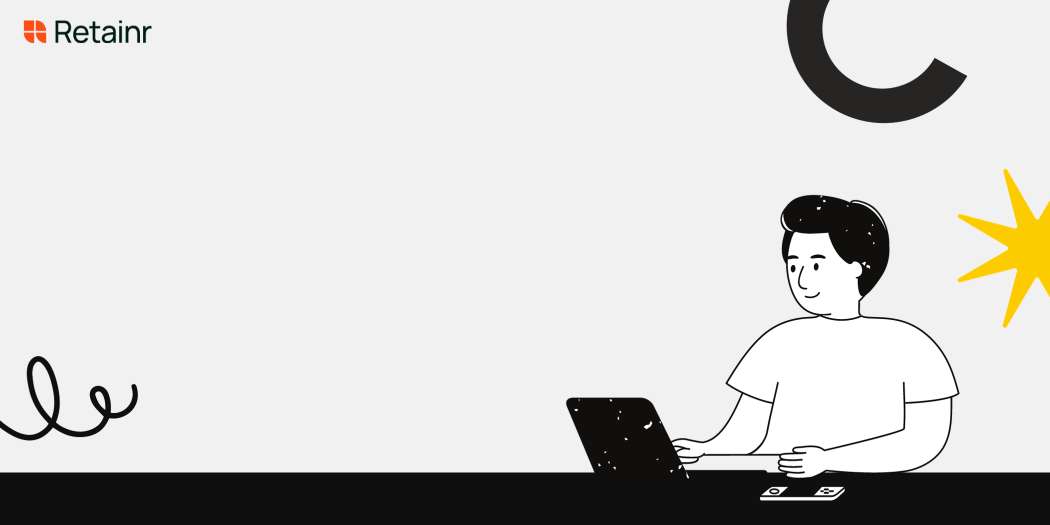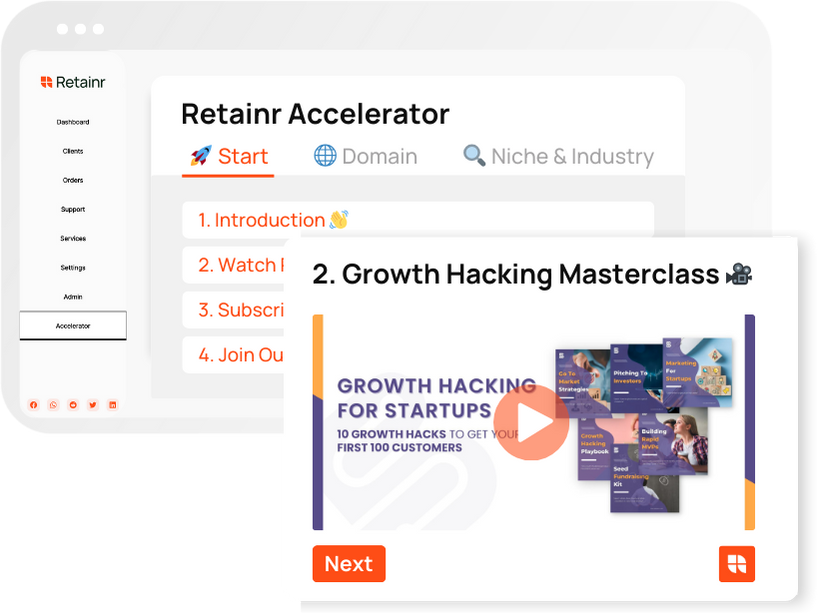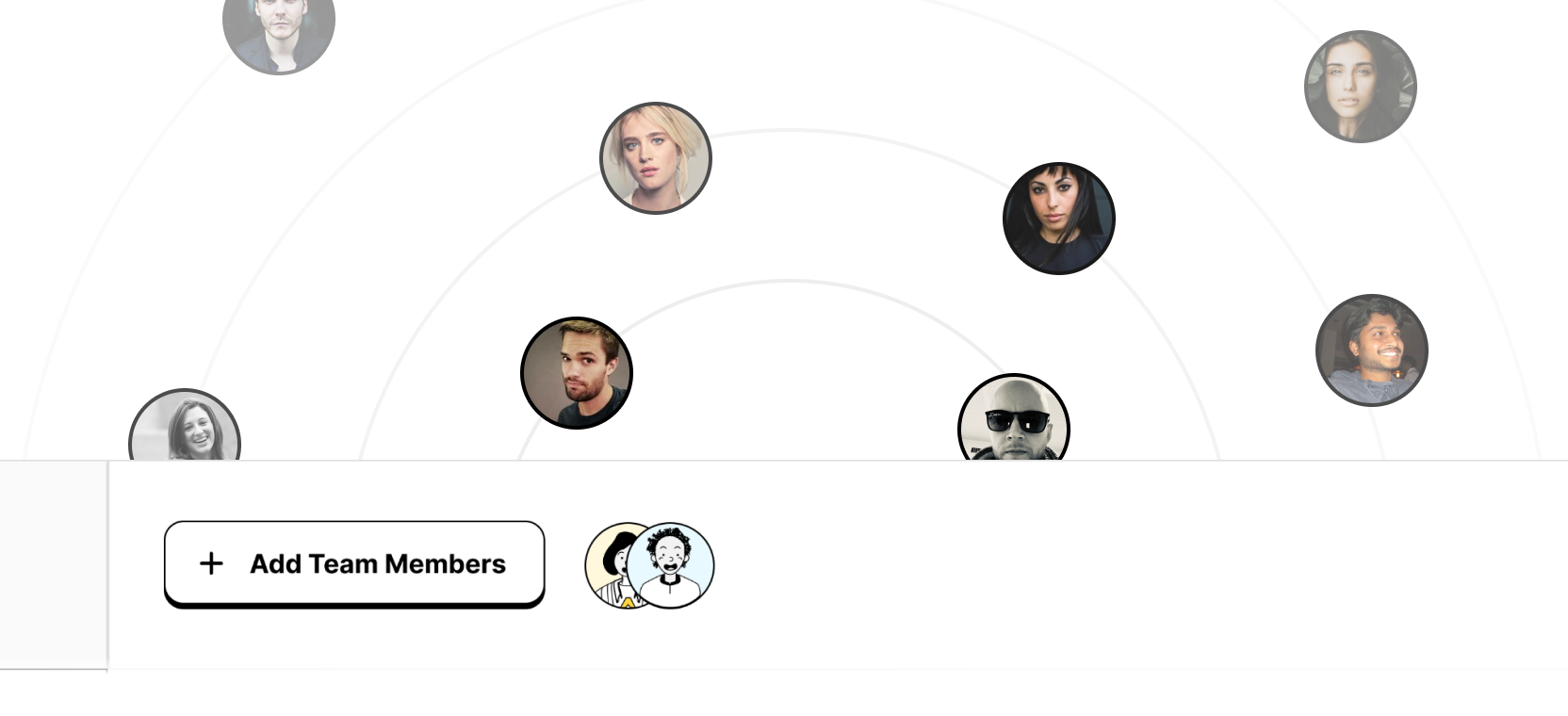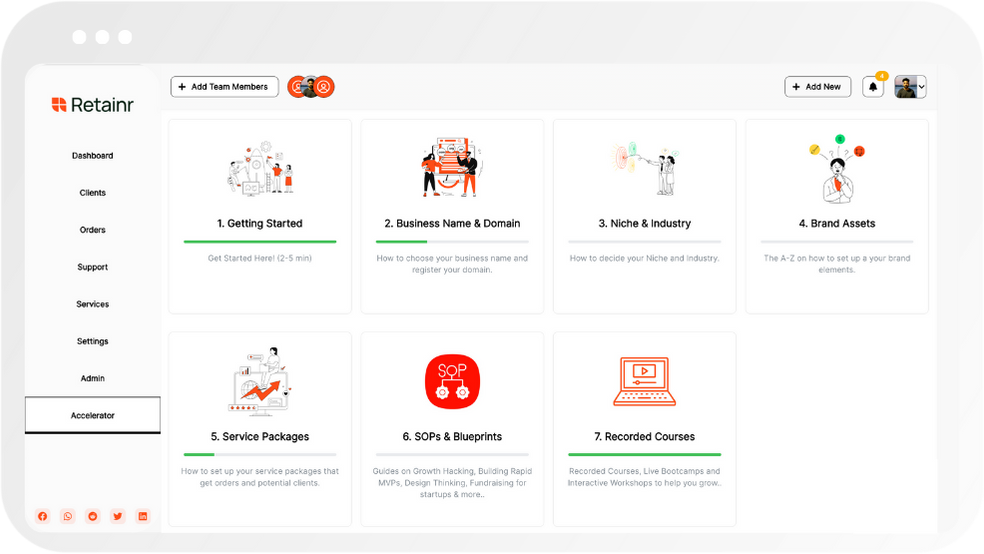
7 Strategies for Balancing Work and Personal Commitments
Build with Retainr
Sell your products and services, manage clients, orders, payments, automate your client onboarding and management with your own branded web application.
Get Started1. What are the 7 strategies for balancing work and personal commitments?
Strategy 1: Time Management
Time management is a crucial strategy to balance work and personal commitments. Planning your day well in advance, prioritizing tasks based on their importance, and setting deadlines for each task can help to distribute your time equitably. Use a planner, digital calendar, or a time-management app to schedule both work and personal events.
Strategy 2: Set Realistic Expectations
Setting unrealistic goals can lead to stress, leading to an imbalance between work and personal life. It's crucial to set achievable goals both at work and at home. Be realistic about what you can accomplish in a day and avoid overcommitting yourself.
Strategy 3: Establish Boundaries
Establish boundaries to separate your work and personal life. This could mean setting specific work hours and not checking work emails or calls after a certain hour. It's also important to communicate these boundaries to your colleagues and loved ones.
Strategy 4: Practice Self Care
| Activities | Description |
|---|---|
| Meditation | Practicing meditation can reduce stress and increase mindfulness. |
| Exercise | Regular physical activity can boost your mood and energy levels. |
| Sleep | Adequate sleep is essential for productivity and overall well-being. |
Strategy 5: Regular Breaks
Take regular breaks during work to relax and recharge. This could be a quick walk, reading a book, or even enjoying a coffee break. It is vital for your mental and physical health, and productivity.
Strategy 6: Delegate Tasks
Delegate tasks when possible at work or at home. It's okay to ask for help when you're overwhelmed with too many responsibilities. Remember, delegating tasks doesn't mean you're incapable, in fact, it shows effective leadership.
Strategy 7: Make Time for Personal Activities
Ensure you are setting aside time for activities you enjoy. Whether it’s hobbies, socializing with friends, or time spent with family, personal activities provide a great outlet for stress and contribute to a greater sense of balance.
2. How effective are these strategies in ensuring work-life balance?
Evaluation of the Effectiveness of Strategies
The effectiveness of strategies to balance work and personal commitments varies depending on numerous factors. Firstly, the nature of your job and personal commitments significantly determine the appropriate strategy to adopt. Secondly, your personality, coping skills and stress tolerance also affect the optimal balance between work and personal life. It's crucial to adjust the strategies flatly based on your unique needs and circumstances.
Exemplification of Strategy Effectiveness
- Time Management: Being able to effectively manage your time is a crucial aspect of ensuring a healthy work-life balance. This involves setting clear goals, prioritising tasks, breaking down projects into manageable tasks, and limiting distractions. A structured approach to time management can increase productivity at work, thereby reducing the likelihood of work tasks encroaching upon personal time.
- Delegation of Tasks: Delegation does not only enhance productivity but also reduces stress levels. By conferring some responsibilities to other parties, one can focus on key areas that require personal attention. This allows the individual to have sufficient time for personal commitments and relaxation.
- Utilization of Technology: With the advent of technology, working smart is more achievable. Utilizing software and applications for scheduling, communication, and project management can significantly increase efficiency and allow for a more flexible work schedule.
How effective are strategies?
| Strategy | Effectiveness |
|---|---|
| Time Management | High |
| Delegation of Tasks | Moderate to High |
| Utilization of Technology | High |
In conclusion, the effectiveness of these strategies in ensuring a balanced work-life ultimately depends on the individual's commitment to implementing and maintaining them. Each strategy has pros, but it is crucial to employ them adequately and consistently for a balanced work-life.
3. How can I effectively implement these strategies in my daily routine?
Implementing Strategies
Implementing these strategies in your daily routine is often easier said than done due to varied commitments one might have. However, with a well-structured plan, consistent effort, and discipline, you might navigate through your work and personal life and achieve a balanced routine. Here are three ways on how you can effectively implement these strategies:
- Time management: Begin by tracking how you currently spend your time including work hours, leisure activities, sleep and other commitments. Once you have mapped out these activities, you can then restructure your schedule to achieve a balance between work and personal commitments.
- Set boundaries: Establish clear boundaries between your work and personal time. Let your colleagues know when you’re not available for work-related issues, avoid checking emails after working hours and designate certain hours for self-care and personal commitments.
- Set priorities: Identify the activities that matter the most to you and ensure that they are given the highest priority. Setting priorities will help you make decisions when you have conflicting commitments.
Sample Routine Table
To exemplify, below is a tabular illustration of how you can plan your routine by applying the strategies discussed above. This may vary depending on your individual needs, preferences, and commitments.
| Time | Work Activities | Personal Activities |
|---|---|---|
| 7:00 - 8:00 | Plan the day ahead | Gym session |
| 8:00 - 12:00 | Core work tasks | — |
| 12:00 - 13:00 | Lunch break | Meal prep |
| 13:00 - 17:00 | Core work tasks | — |
| 17:00 - 18:00 | Wrap up & plan for next day | Leisurely walk |
| After 18:00 | — | Family time |
Consistency is Key
Remember, consistency is key in maintaining balance in your routine. Make small changes every day, stick to the schedule you set, and make sure to rest. Ingraining these strategies into your daily life requires not just structure and discipline, but also self-care and understanding. The aim is to minimize stress and maximize productivity, satisfaction, and general well-being in both work and personal life.
4. How can these 7 strategies improve my productivity at work and at home?
Improving Productivity at Work
Implementing the 7 strategies can lead to increased productivity in one's professional life. Firstly, setting clear boundaries allows you to concentrate fully on work during work hours, improving efficiency. Secondly, utilising technological tools for time management, such as digital calendars and task managers, can streamline workflow, reducing time spent on organisation. Lastly, by prioritizing tasks effectively, more important tasks get completed more efficiently, and less important tasks are dealt with appropriately.
| Strategy | Impact on Productivity |
|---|---|
| Setting Boundaries | Improved Focus |
| Technological Tools | Efficient Workflow |
| Task Prioritization | Effective Task Completion |
Improving Productivity at Home
Similarly, these strategies can also enhance productivity in one’s personal life. Scheduling personal activities and adhering to the plan can manage time effectively for household chores, hobbies, and social activities. Regular breaks from work or any task can prevent exhaustion, keeping you refreshed and reenergized to perform better. Also, maintaining work-life balance through these strategies can promote better mental health, thus reducing the chances of productivity dips caused by burnout or stress.
- Schedule Adherence: Time management for personal tasks
- Regular Breaks: Prevention of exhaustion, improved performance
- Mental Health Maintenance: Reduced productivity dips due to stress
5. Can these strategies be applied to all types of professions or jobs?
Applicability of Strategies in Diverse Professions
The strategies for balancing work and personal life may not always directly apply to all types of professions. This is primarily due to the divergent dynamics and demands that each profession encapsulates. However, the essence of these strategies holds universal applicability and can be adapted accordingly.
Professions with Fixed Work Hours
- Profession: 9 to 5 Office Jobs
- Profession: Healthcare workers
Professions with fixed work hours like typical office jobs can follow these strategies with fewer modifications. For instance, adopting practices like task prioritization, efficient time management, proactive communication for balancing workloads can be directly implemented.
Healthcare workers though have set shifts, they often have unforeseen emergencies. They can employ strategies like setting boundaries and ensuring dedicated off-duty hours to prevent burnout.
Professions with Variable Work Hours
| Profession | Possible Adaptations |
|---|---|
| Freelancers | Freelancers can benefit from these strategies by particularly focusing on creating a designated workspace at home and setting a structured daily routine to avoid work seeping into personal time. |
| Entrepreneurs | Entrepreneurs may find it beneficial to rely on delegation and automation aspects of these strategies to manage demands of their multiple roles and to ensure sufficient personal time. |
In summary, while each profession or job type may require a degree of customization, the strategies for balancing work and personal commitments are broadly applicable with the right kind of practical adaptations.
6. How much time should I expect to see improvements after applying these strategies?
Time Expectations for Improvement
Timing for seeing improvements after incorporating the strategies designed to balance work and personal commitments can vary. Many factors come into play including individual adaptation speed, intensity of effort, and the chosen strategy's nature. Here is a simple guideline that may help understand the timeline.
- Immediate benefits: Some strategies such as time blocking, prioritizing tasks, or delegation can lead to immediate improvements. You may find yourself accomplishing tasks quicker or having extra time for personal endeavors.
- Short-term (few weeks): Practices like developing a routine or learning to say no may take a few weeks to show improvements. They require habit formation and a shift in mindset.
- Long-term (few months): Strategies that involve devising long-term goals, self-care, and establishing work boundaries generally show results over a few months. They involve deeply ingrained changes and bear results that are sustained over a longer period.
Although the above timeline suggests when you might see improvements, remember that the exact timing can differ. It can be useful to track your progress using simple indicators like energy levels, fulfilment with work or personal life, and overall stress levels. Going at your pace while staying consistent is key to reaping these strategies' benefits.
| Strategy | Expected Time for Improvement |
|---|---|
| Time Blocking/Prioritizing | Immediate |
| Developing a Routine/Saying No | Short-term (few weeks) |
| Long-term Goals Setting/Self-Care | Long-term (few months) |
7. What kind of commitment or sacrifice is needed for these strategies to be effective?
Commitment and Sacrifice for Work-Life Balance
Staying committed to creating a balance between work and personal life requires dedication, discipline, and sacrifice. Implementing work-life balance strategies may involve giving up certain practices and cultivating new habits. Below are some of the sacrifices and commitments one needs to be ready to make.
- Time Management: Being strict with your time could mean saying no to certain engagements which are not aligned with your priorities. Time should be allocated wisely to essential tasks and priorities.
- Dedication: Ensuring work-life balance requires dedication to adhere to set schedules without being swayed by distractions that could derail your plan.
- Mindset Shift: Creating a work-life balance requires a paradigm shift. Acknowledge that you can't do everything perfectly and let go of the perfectionism mindset. Accept that there will be good days and bad days.
- Setting Boundaries: Be ready to communicate your needs to your employer and colleagues effectively. Do not be afraid to set boundaries at work or to ask for flexibility when needed.
The Importance of Commitment and Sacrifice
These sacrifices and commitments are crucial in ensuring that the work-life balance strategies put in place are successful. The table below summarizes the importance of each commitment.
| Commitment/Sacrifice | Importance |
|---|---|
| Time Management | Optimizes productivity and ensures neither work nor personal life is neglected. |
| Dedication | Without dedication, work-life balance strategies cannot be effectively implemented and maintained. |
| Mindset Shift | Understanding that perfection isn't always achievable helps reduce stress and anxiety. |
| Setting Boundaries | Helps in preventing one sphere of life from intruding into the other, maintaining a healthy balance. |
Concluding Thoughts on Commitment and Sacrifice
In conclusion, for work-life balance strategies to be effective, one must embrace certain commitments and sacrifices. They form the foundation in ensuring you attain your desired work-life balance. While these changes may seem challenging initially, they lead to modulated living in the long run, ensuring productivity at work and satisfaction in personal life.
8. Are these strategies suitable for people in high-stress job environments?
Strategies Suitability in High-Stress Job Environments
These strategies are particularly beneficial for individuals in high-stress job environments. The higher the level of stress at work, the more critical it is to maintain a solid balance between work and personal commitments. A lack of balance could lead to burnout, decreased productivity, and serious health issues.
Specific Strategies for High-Stress Jobs
- Delegation: This becomes crucial in high-stress jobs. Delegating tasks can reduce workload and stress levels. Working in a team and trust others can significantly reduce the amount of work and stress.
- Time Management: Proper scheduling can help break up large tasks into manageable parts, which reduces the amount of stress associated with a particular task.
- Regular Breaks: Taking regular breaks can help reduce stress and improve concentration levels. This becomes more pertinent in high-stress job situations where sustained focus is required.
Adaptability of Strategies
| Strategy | Adaptability in High-Stress Job Environment |
|---|---|
| Regular Exercise | Highly adaptable, can be done before or after work hours for stress relief |
| Proper Diet | Adaptable, preparation must be done in advance to accommodate busy schedules |
| Adequate Sleep | Highly adaptable, must prioritize to ensure enough rest for recovery |
In conclusion, these strategies are not only suitable but also critical for people in high-stress job environments. Adjustments might be necessary to accommodate specific job demands, but with commitment and discipline, these strategies can be successfully implemented to improve life quality and job performance.
9. Can these strategies contribute to improving my mental health?
Impacts of Strategies on Mental Health
Maintaining a balance between work and personal life can significantly contribute to the improvement of your mental health. Incorporating the right strategies will help reduce stress, inevitably leading to better mental wellbeing. Here are the ways in which these methods can have positive effects on your mental health:
- Reduced Stress Levels: Stress is a significant contributor to various mental health issues. When you can balance work and personal life effectively, it eliminates work-related stress, thus improving mental health.
- Enhanced Self-esteem: Successfully juggling personal and work life can increase your confidence and self-esteem, positively influencing your mental health.
- Improved Relationships: Balancing work and personal life allows you to spend quality time with your loved ones. This can result in happier relationships, which can be beneficial to your mental health.
Key Strategies for Mental Health Improvement
Here are crucial strategies that can help improve your mental health by balancing your work and personal life. These include prioritizing your health, setting boundaries, and taking breaks:
| Strategy | Description |
|---|---|
| Prioritize Health | Taking care of your physical health is equally significant to work commitment. Regular exercise, balanced diet, and adequate sleep can significantly enhance your mood and energy levels. |
| Set Boundaries | Define clear lines between your work and personal life. This might involve setting specific work hours and not responding to work emails or calls after these hours. |
| Take Breaks | It's important to take regular breaks during your work to unwind and debrief. This can be as simple as taking a short walk or meditating for a few minutes. |
In Conclusion
Keeping a healthy balance between work and personal life is crucial for your overall well-being and particularly your mental health. By applying these strategies, you can reduce potential stressors, boost your self-esteem and promote healthier relationships. Remember that your health is a priority, setting clear boundaries will protect your personal time, and taking regular breaks can effectively combat stress-induced mental fatigue. By taking active steps to maintain this balance, you are also taking care of your mental health.
10. How can these strategies help me in dealing with job burnout?
Effects of Balancing Strategies On Job Burnout
Effective balancing of work and personal commitments are crucial in the prevention of job burnout. Job burnout, a significant issue for many professionals, is characterized by feelings of exhaustion, cynicism, and reduced effectiveness at work. Here is how the strategies can help:
- Delegation: This can greatly reduce workload thereby reducing stress and exhaustion.
- Setting Boundaries: Knowing when to say no to additional work can help maintain a healthy work-life balance.
- Time Management: Prioritizing tasks can lead to more efficient use of time, reducing feelings of being overwhelmed.
- Regular Breaks: Taking time off can help refresh the mind and reduce the likelihood of burnout.
- Mindfulness: Being present in the moment can help reduce anxieties about the past or future.
- Maintaining A Healthy Lifestyle: Regular exercise, a balanced diet, and sufficient sleep can boost mood and energy levels.
- Use Of PTO: Taking advantage of Paid Time Off can provide opportunities for relaxation and rejuvenation.
Understanding How Strategies Reduce Job Burnout
The table below highlights how each strategy contributes to reducing job burnout:
| Strategy | How It Reduces Job Burnout |
|---|---|
| Delegation | Reducing the workload. |
| Setting Boundaries | Preventing work-overload. |
| Time Management | Increasing efficiency and preventing feelings of being overwhelmed. |
| Regular Breaks | Refreshing the mind. |
| Mindfulness | Decreasing anxiety. |
| Maintaining A Healthy Lifestyle | Boosting mood and energy levels. |
| Use Of PTO | Providing opportunities for relaxation and rejuvenation. |
Conclusion
Work Life Balance: 7 Successful Strategies
Striking a perfect balance between work and personal life is crucial for productivity and wellness. Achieving work-life balance can enhance your efficiency and overall happiness. Here are seven well-crafted strategies to help in achieving this equilibrium.
1. Prioritize and Delegate
Prioritizing the most critical tasks and delegating responsibilities can alleviate the workload and stress.
2. Set Boundaries
You must set precise boundaries between your work and personal lives, ensuring you do not overlap one into the other.
3. Utilize Work Management Tools
This is where Retainr.io comes in. This powerful white-label software designed to Sell, Manage Clients, Orders & Payments with Your Own Branded App can dramatically improve your work productivity, leaving you with ample time for personal commitments.
4. Exercise and Stay Healthy
A healthy lifestyle can reduce stress, boost your mood, and enhance your efficiency.
5. Create Personal Time
Make sure to create and protect personal time for relaxation or pursuing hobbies for a balanced lifestyle.
6. Develop a Flexible Routine
Developing a flexible routine can help manage unexpected situations without complex disruptions of your routine.
7. Seek Support
Never hesitate to seek support from friends, family, or a professional coach to assist in achieving a work-life balance.
Invest a part of your strategy into using innovative tools like Retainr.io. Retainr.io can streamline work management processes with simplicity and efficiency. Don't let the burden of tasks weigh you down, use Retainr for easy and smooth work management.
Boost Your Agency Growth
with Retainr Accelerator
Uncover secrets, strategies, and exclusive blueprints to take your agency's growth to the next level — from marketing insights to effective presentations and leveraging technology.

SOPs, Cheatsheets & Blueprints
Leverage 50+ SOPs (valued over $10K) offering practical guides, scripts, tools, hacks, templates, and cheat sheets to fast-track your startup's growth.
Connect with fellow entrepreneurs, share experiences, and get expert insights within our exclusive Facebook community.
.jpg)

Join a thriving community of growth hackers. Network, collaborate, and learn from like-minded entrepreneurs on a lifelong journey to success.

Gain expertise with recorded Courses, Live Bootcamps and interactive Workshops on topics like growth hacking, copywriting, no-code funnel building, performance marketing and more, taught by seasoned coaches & industry experts.

.jpg)

.jpeg)


